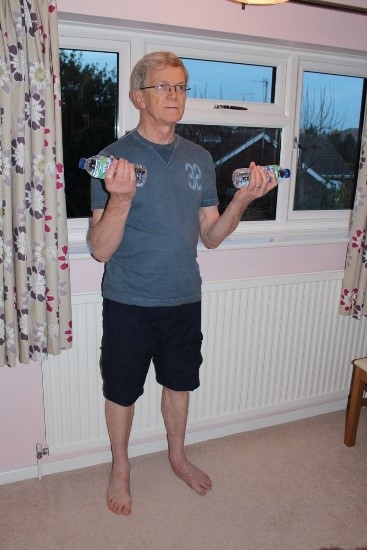Welcome back! We hope you have had a good week and have managed to start fitting some home exercising into your daily routine.
The exercises described in Week 1 focused on your lower body strength and improving balance. In week 2 we suggest you continue to include these in your exercise routine but add in a few exercises for your upper body.
Arm strength
Keeping your upper body strong is important to maintaining your ability to do lots of daily activities comfortably and easily. Pushing yourself up from a lying position, carrying your shopping and pushing the vacuum cleaner all take strength in your arms and shoulders. So, try a few of the following exercises with any light weights you have around the house. Cans of food can be really useful for this!
Before you start exercising, please check back over the safety advice described in Week 1. We want to be sure that everyone stays safe. In addition to that advice people who have been diagnosed with hypertension (high blood pressure) should not physically exert themselves with exercises where they hold their arms above the level of their heart while in an upright position. This advice reduces the risk of dizziness. If you do not have hypertension, performing exercises with your arms above your head is OK, however remember that if you feel dizzy during any exercise or movement, you must safely stop exercising, inform somebody nearby (where possible) and rest until symptoms completely disappear.
It is also important to prepare your body for exercise. Warm up as described in Week 1, marching up and down inside or walking outside until you feel a little warmer and your breathing is a bit faster than normal. Then complete your usual routine of lower body exercises, but adding in the following arm routine.
Shoulder Press
In a standing or seated position, start with your hands out to the side and level with your ears then raise your arms directly above your head. At all times try to maintain an upright posture. Use tinned food or water bottles as weights.

Bicep curl
Using tinned food, water bottles or any other easy to grip objects start with your hands down by your side with the palms facing forward. Bend your elbow to bring your hands to chest height. Whilst performing this exercise maintain a strong grip to improve forearm strength as well as biceps.
After your exercise session, it is good to spend a few minutes stretching and cooling down, so follow the cool down tips from Week 1.

Variety and progression
After a couple of weeks of repeating these exercises fairly regularly they should become a little bit easier than they were when you first started. If that is the case, in order to keep improving your strength and balance, it is a good idea to start to increase the difficulty and/or intensity of each exercise.
• Increase the number of repetitions: for example, stand-up and sit down 10 times in a row instead of 5.
• Increase the time spent performing the activity: for example, increase the amount of time spent with your knee lifted in a single leg balance, count to 20 seconds instead of 10 seconds.
• Speed of movement: for example, a stand-to-sit exercise may take up to 10 seconds to perform. Once you have become familiar and confident performing this movement regularly, you may wish to speed up the time it takes you to stand up from a seated position from 5 seconds down to 3 seconds and then to 2 seconds (do not worry about the length of time it takes to sit down from a standing position).
We hope that you are developing the habit of exercising and are feeling better for it. Next week we’ll talk about why sitting for too long (even if you are doing a regular home exercise session) can be bad for your health and we’ll suggest some tips for breaking up this sedentary time.
Stay safe and keep moving!
Janet, Afroditi, Jolanthe and Pete
Dr Janet Withall, REACT Trial Manager, University of Bath
Dr Afroditi Stathi, REACT Chief Investigator, University of Birmingham
Dr Jolanthe de Koning, REACT Research Associate, University of Bath
Dr Pete Ladlow, UK Defence Medical Rehabilitation Centre
Respond